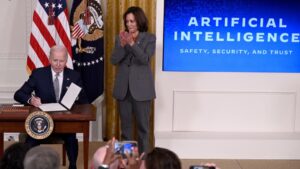On Thursday, March 28, 2024, U.S. Vice President Kamala Harris and the Office of Management & Budget (OMB) announced a sweeping new policy to promote the safe use of AI by the federal government.
The policy includes three binding requirements that mandates all federal agencies: to provide concrete safeguards against AI harm; to provide transparency for AI use cases; and to appoint a Chief AI Officer.

US VP Kamala Harris applauds as US President Joe Biden signs an executive order on advancing the safe, secure, and trustworthy development and use of AI in Washington, DC 10/30/23. Brendan Smialowski | AFP | Getty Images
“These new, binding requirements will promote the safe, secure and responsible use of AI by our federal government,” Vice President Harris said.
Her statement underscored the White House’s vision that AI should be used to protect public safety and advance the public interest.
The three binding requirements in The White House’s new order include:
1. SAFEGUARDS (due Dec 1 2024): The first binding requirement mandates that federal agencies implement “concrete safeguards” when using AI, and agency CAIOs must verify that the AI tools they use will “put the public interest first and that “do not endanger the rights and safety of the American people.” The policy requires agencies to “assess, test, and monitor” the impact of AI on the general public, mitigate the risks of algorithmic discrimination and bias, and provide the public with transparency into how the government is using the technology. If an agency cannot guarantee such safeguards, it must stop using the AI system or justify its continued use, for example, if agency officials can prove that doing so would create an “unacceptable” impact on critical operations. U.S. agencies have until December 1, 2024 to implement these safeguards.
2. TRANSPARENCY/INVENTORY (annual): The 2nd requirement mandates more transparency about government AI systems. It requires federal agencies to publish an annual inventory of their AI systems, an assessment of the potential risks they pose, and an explanation of how they are managing those risks, as long as the release of such information does not pose a threat to the public or government.
“When government agencies use AI tools, we will now require them to verify that those tools do not endanger the rights and safety of the American people,” Vice President Harris said.
3. CHIEF AI OFFICERS + AI GOVERNANCE BOARDS (due within 60 days): The third and final binding requirement directs every federal agency to designate a Chief AI Officer whose role is to coordinate the use of AI within their agencies, within 60 days (by May 27, 2024). Agencies are also required to establish AI Governance Boards to coordinate and govern the use of AI across agencies. Several federal government agencies have already hired Chief AI Officers, and some have created AI boards, including the departments of Defense, Veterans Affairs, Housing and Urban Development and State.
“Finally, we are requiring that every federal agency designate a Chief AI Officer who has the experience, expertise and authority to oversee all AI technologies being used by that agency. This is to make sure that AI is used responsibly, understanding that we must have senior leaders across our government who are specifically tasked with overseeing AI adoption and use,” Vice President Harris said of the Chief AI Officer role on the 3/28/24 White House briefing call.
For more information, see:
- Press Call by Vice President Harris/OMB on Artificial Intelligence (3/28/24)
- Fact Sheet on the Order on AI from OBM and the White House (3/28/24)
- CBS News “White House orders federal agencies to name Chief AI Officers“
Want to learn more, and meet some of those new CAIOs in person?
Join our 11th CDAO Summit & 3rd Chief AI Officer Summit Tue-Wed October 1-2, 2024.
Delegates, speakers, and sponsors can participate in one or both events.
 |
 |
- Angela Cough: Senior Advisor, Digital Talent, Chief Digital and Artificial Intelligence Office, U.S. Department of Defense
- Anthony Scriffignano: Distinguished Fellow, Alfred Lee Loomis Innovation Council, The Stimson Center
- Austin Gerig: Chief Data Officer, U.S. Securities and Exchange Commission
- Brian Peretti: Deputy Chief Artificial Intelligence Officer and Director Domestic and International Cyber Policy, U.S. Department of the Treasury
- Daniel Bernard: Chief Product and Technology Officer, Hearst Magazines
- David Chivers: Former President, Publisher, CDO at WSJ, Dow Jones, USA Today, Gannett, Des Moines Register, Meredith Corporation
- David Mathison: CEO, CAIO Summit/CDAO Summit; CDO Club
- Diane Staheli: Assistant Director, AI Applications, Office of Science and Tech Policy, The White House
- Dr. Delester Brown Jr: Chief Data Officer, National Guard Bureau
- Dr. Mike Horton: Deputy Chief Data Officer, US Department of Transportation (DOT)
- Florin Rotar: Chief AI Officer, Avanade
- Iwao Fusillo: Global Head of Data & Analytics – eCommerce, PepsiCo
- Marie Falkowski: Deputy IC Chief Data Officer & Deputy ADNI for Data & Partnerships, Office of the Director of National Intelligence
- Mark Brady: Deputy Chief Data Officer for TRMC, KBR, Inc.
- Marc Lavallee: Director of Technology Product and AI Strategy/Journalism, Knight Foundation
- Mark McCreary: Partner, Chief Artificial Intelligence & Information Security Officer, Fox Rothschild
- Paul Evangelista: Chief Data Officer, U.S. Military Academy at West Point
- Sonal Shah: CEO, The Texas Tribune
- Spence Green: CEO, Lilt
- Tanya Dua: Technology Editor, LinkedIn
- Thomas Sasala: Deputy Director, Office of Enterprise Management, U.S. Army
- Vinay Vijay Singh: Chief AI Officer, U.S. Department of Housing and Urban Development
- Vivian Schiller: VP and Executive Director, The Aspen Institute
- Yudong Cao: Chief Technology Officer, Zapata AI
- More to come, stay tuned!
THANK YOU to our all-star partners:
☆ LILT: https://lilt.com
☆ Zapata AI: https://zapata.ai
☆ Domino Data Lab: https://domino.ai
☆ govCDOiq: https://govcdoiq.org
☆ CDO Club: https://CDOClub.com











